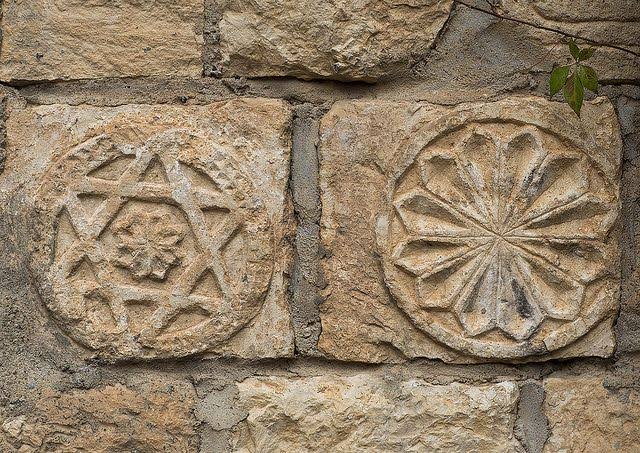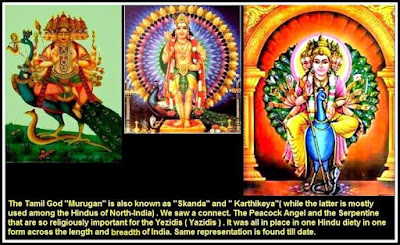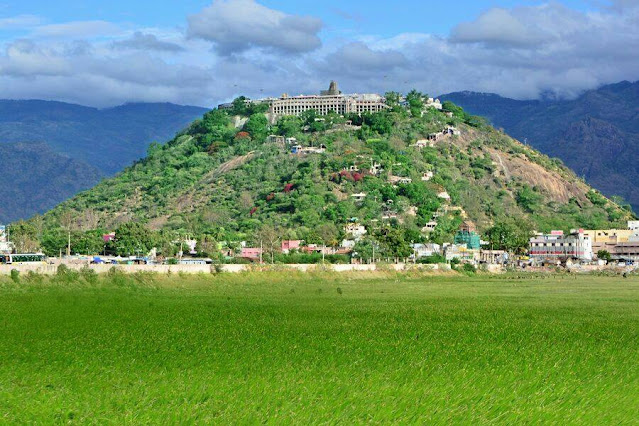As Yazidis are from Hindu community, they follow many hindu traditions and rituals. According to the oral history of Yazidis, several thousand years before, they lived in India, Perani was their holy place. Then, later they migrated to Persia via Persian gulf. They also believe in the concept of Karma and rebirth, like in Hinduism.
Check the below picture of Yazidis temple at Lalish in Iraq. Their temple is looking similar to a Hindu temple.
Yazidi's religion has many elements which are similar to Hindu rituals. Also, within their religious framework they preserved some of the very ancient beliefs that is no longer surviving in any other religion. Yazidi's religion can be traced back to ancient Mesopotamia religion.
Below picture: Yazidi's priest performing a homam / yagna with fire, like Hindus...

Yazidi women lighting a fire (Arti ritual in Hinduism) and worshiping their god...
Yazidi priest applying Tilak on the forehead, like Hindus...
Hindu symbols like star and flower carved in Yazidi's temple...
This is a six pointed star, which is a symbol of Lord Murugan / Karthikeya in Hinduism...
As Yazidis are hindus and following hinduism, they are forced to convert to Islam. ISIS declared that Yazidis are Satan worshipers.
In August 2014, the Yazidis became victims of a genocide by the Islamic State of Iraq and the Levant in its campaign to eradicate non-Islamic influences. The reason that ISIS attacks the Yazidi community in this way is because they view them as pagan and polytheistic because they’re outside of the Abrahamic religions that's having a written scripture.
The genocide led to the expulsion, flight and effective exile of the Yazidis from their ancestral lands in Upper Mesopotamia. Thousands of Yazidi women and girls were forced into sexual slavery by the Islamic State, and thousands of Yazidi men were killed.
Thousands of Yazidis died without food or water. People were too weak to flee from the mountains of sinjar and millions of Yazidis had died when ISIS entered their mountains. They gunned down thousands and thousands of Yazidis. 210,000 died in all. Women were raped and sold in the marketplace for as little as US $10. Swords and knifes were used to decapitate the Yazidi men who had been captured. Most refused to convert to Islam and rather preferred to be beheaded.
500,000 Yezidis are now refugees in Syria.
Joanna Palani, a brave daughter of Iranian Kurds had fought for kurds against ISIS, on the front line of Syria in 2016. Her surname 'Palani' indicates that she belongs to 'Palani' tribe of Kurds.
'Palani' tribe is one of the most powerful kurdish tribe in Iraq.
Who are Kurds?
Why this group of kurds are called as 'Palani' ???
What is the meaning of palani?
How Yazidis are connected with Tamil people ?
Continue to read, to know answers for all these questions...
Quote from Wikipedia,
"The Yazidi religion is monotheistic and has roots in a western pre-Zoroastrian Iranic faith."
Note the word, Pre Zoroastrian.
Zoroastrianism - is often compared with Vedic civilisation and there are many similarities between these two. So, Pre Zoroastrian means - pre Vedic civilisation.
What is Pre Vedic civilisation ???
Pre Vedic is none other than 'The ancient Tamizh / tamil civilisation'. This post will uncover the connection between Yazidis and ancient tamils, with appropriate references.... Tamil civilisation existed before the start of Vedic civilisation. Also, Tamil civilisation had laid foundation for the Vedic civilisation, if you want to trace the true origin / history of Akand Bharat, then have to look beyond vedic civilisation, to know the true age of civilised Bharat. When the roots of vedic civilisation is traced, then one can see an acclaimed buried truths of one huge pre-vedic civilisation!!
For more information regarding pre-vedic civilisation, reach out below series...
Now, coming back to the topic of Yazidis, Yazidis worship a peacock angel called 'Melek Taus', an emanation of God and good. So, Yazidis were called as the children of Melek Taus.
Symbol of peacock was used in many places in Persia and by the Persian kings. It has a special and unique place in their kingdom. Also, peacock imagery adorns Yazidi shrines, temples, their gateways, graves, and their houses of worship.
But, Peacock is not indigenous to middle east countries like Iran, Iraq, Turkey, Armenia and Syria, instead peacock is indigenous in India. So how come peacock was famous over there and why did they engrave peacock images everywhere in their temples and worshiping it?
HERE STARTS THE CONNECTION OF YAZIDIS WITH TAMILS....
Peacocks exist only in India.
Melek or Malik is an ancient Semite god of Babel and Canaan. Melek or Malik is derived from the ancient Tamil word Malaikavon, which is another name for Lord Murugan.
Below is the picture of the multi-armed Yazidi god. Multi armed god idols exist only in Hinduism. The peacock image in the background and the snake representing Kundalini is their version of Lord Murugan. Lord Murugan is much revered god in South India, especially in Tamil Nadu.
Actually, The GOD of the Yazidi's is son of Lord Shiva and Parvati, i.e Lord Murugan ( Kartikeya/ Subramanya ). Kartikeya's elder brother is Lord Ganesha.
Peacock is the vahana of Lord Muruga, thats why peacock is being worshiped by Yazidis and peacock motifs are popularly used in many Persian designs, palaces and Yazidis temples.
Yazidi's symbol is a lamp with a peacock on it's top.
Yazidis use oil lamps for worshiping, which has peacock on the top. This is similar to the custom followed in Tamil nadu and the peacock lamp is called as 'Mayil vilaku' in tamizh.
Oil lamp in yazidi temple... Women are lighting these lamps in their temple...
Below picture is the temple of Yazidis, which is situated in Iraq. Yazidi children are playing in their temple...

Look at the temple of yazidis at Lalish in the above picture. The women in saree, the style of saree draping, the hair style of women with flowers and she lighting their holy peacock lamp, isn't she resembling like a Tamil women?
Check the picture below, a south indian women is lighting a peacock lamp in India...
It is indeed proving that yazidis are hindus and they are originally from the land of ancient Tamizhakam.
In fact Yazidis are Hindu brahmins who were priests at Gobekli tepe and many hindu temples in Turkey, Iran, Iraq and Syria....
These points that, Yazidis worshiping Lord Murgan and peacock are NOT the only references for Tamil connection and ancient tamizhakam. It is just a preface.
I have explained in detail with many references and sub references to prove that Yazidis were rooted from ancient tamils. Please read this post completely, to know more strong and supporting points for the same....
References for Yazidis and Tamils connection
The ancient and earliest people in Persia were tamizh people and to be precise they were dravidians, who were migrated from tamizhakam. Yazidis worshiped tamizh deity Lord Murugan and named many places in Persia after him. Murugan's symbols such as six pointed star, peacock and snake were also engraved in their temples and worshiped by yazidis...
In Tamil, Lord Murugan is also called as Kandhan, Kumaran, Saravanan. There are places in Persia, which are named after tamil names of Lord Murugan. Why was it named in tamizh?
Example: A place called 'Saravan' in Gilan province of Iran.
Tamil names of Lord murugan was used to name places in Persia. Example: Check the below picture for the places that are named in tamil in Turkey...
All these are proper Tamil names of Lord Murugan. If the early persians / yazidis weren't tamils, then why did they name these many places in Persia in Tamil???
Couldn't believe that Yazidi's are Tamils... Then, lets know the answer through the below questions,
1. Who are Kurds?
One can ask any Iranian or persian people regarding the origin of the name Kurds. No one knows it, because, it is derived from tamizh language....
To know the truth, one needs to look through Tamil...
Lord Murugan married his consort Valli, Valli is the second consort of kartikeya and she belongs to a forest people group called Kuravar. Kuravars are tamizh tribes of Kurunji region (mountain region).
These kuravars / Kurunji people were migrated to Persia, resided in persian mountains and hence called as 'KURDS'.
According to tamizh sangam literature, landscapes were classified into five divisions. - Kurinji landscape - the hilly region,
- Mullai landscape - the forest land,
- Marudam / Marutham landscape - the cultivable land
- Neidal / Neytal landscape - the sea-shore, associated with pining.
- Palai landscape - desert, associated with separation.
In Iran, there are places called 'kurinji' and 'Neytal', which exactly matches with the type of landscapes mentioned in the tamil sangam literature.
Naming places in tamil in Persia, that too naming it according to the Sangam landscape divisions, doesn't it look suspicious?
As Tamizh kurunji people had migrated and lived in the mountain regions of Persia, they were called as Kurds.
Let us see about more references, to support this point
1.1. Northern Kurdish group is called as Kurmanji. Isn't it similar to Kurunji, a tamil landscape????
1.2 Southern Kurdish group live in Ilam, Lorestan etc.. I have already published a post called, 'Kumari kandam - Part 6 (Elam civilisation of Iran)'. This post explains in detail with proofs that ancient Ilam people in Iran were Tamizhs. For more information about it, reach out to,
Yazidi people were one of the kurinji people, so they inhabited near Caucasus mountains and Sinjar mountains. Yezidis were originally known as 'Ezidi', which is derived from Elam in tamizh....
2. Why did the Yazidis worship Lord Murugan specifically?
As per tamil sangam literature, each landscape is associated with a particular deity to worship.
Kurunji Landscape - mountain region - associated with - Kottravai and Murugan deity.
So, as per the sangam literature, Kurunji people worshiped Kottravai and Murugan Gods. Murugan is considered as God of hill people and so they named many places after him in Persia. Valli is Lord Murugan's second consort.
'Vali' - is name of a village in Khuzestan Province of Iran.
There is also a place in Iran named as 'Kurinji'.
Valian - also known as Velian is a village in Alborz Province, Iran. For more information about tamil civilisation in Iran, reach out to,
https://divinediyaas.blogspot.com/2021/03/tamizh-kings-and-culture-in-ancient.html
https://divinediyaas.blogspot.com/2021/03/tamizh-kings-and-culture-in-ancient-Iran-part2.html
https://divinediyaas.blogspot.com/2021/03/tamizh-kings-and-culture-in-Iran-Part%203.html
As Yazidis were kurunji people, they resided in Sinjar mountains in Iraq and their holy site is also located in that mountain. They worshiped Tamil god Murugan and his symbols as well, such as peacock and snakes at their temples....
Check the picture below for reference. Yazidis temple with snake at the side wall.
The common motif - peacock of Yazidis and Murugan are symmetrically disposed on both the sides - a feature taken from Persia which denotes the psychic duality of man drawing its life force from the principle of unity.
Pazhani is one of the ancient temple in Tamil Nadu and is famous for the ancient 'Navapashanam' idol of Lord Murugan.
Navapaashanam - means nine poisonous minerals. This idol of Lord murugan was made of nine poisonous minerals by a great Siddhar Bhogar. He was expert in metallurgy and he made Shiva lingams using palladium group of metals infused in mercury. The amalgamation of the navapashanam was prepared through a secret process and it is considered as 'elixir of mankind'.
Abhishekam - meaning bathing of deities. The water used to bath this Navapaashanam idol of Lord Murugan is called as 'Elixir of life'. This holy water has numerous medicinal values and cures many incurable diseases, it gives strength and energy to the people who consumes it.
How did the Siddhars convert a poison into healing elixir of life ??
Ancient Siddhars of tamizhakam had a great knowledge of converting inorganic substances into a nano and ionic form which is easily absorbed by the human cells. Mercury, is widely used in Siddha medicines. Mercury, a killer poison, is converted into healing nectar, when properly purified and processed.
Navapashanam was not made due to sheer human brilliance, a true wisdom of knowledge was gained from the universe (God) , which helped siddhars to make Navabhashanam. Siddhar means - one who attained spiritual perfection / consciousness and the power to control the physical realm.
Navapashanam contains “high positive energy”. It also acts as a catalyst to awaken ones self.
Maharshi Agastiyar / Agastya was the first one to solidify mercury through the use of herbs. Siddhars converted a silver into Gold, by a single touch, they were mastered in Asta siddhis. The Siddhars also consumed purified mercury, Iridium, Rhodium and gold in order to achieve physical immortality.
Many great Siddhars resided and did penance in the hills of this pazhani temple. Some local people are believes that even today there are few Siddhars, who are invisibly residing in this Pazhani hills....
For Yazidis, Pazhani temple of Lord Kartikeya in Tamil nadu is like a Kula deviam (Family god), so yazidis worship him without fail through his symbols. Now, one can see why there are so many peacock motifs in Persia and Yazidi's temples!!
The history of Yazidis, their religion, their ancestral roots from tamizhakam, the naming convention of kurds, their holy place, tribal name of kurds and their rituals are proving that Yazidis are none other than Tamil hindus, who worships Lord Murugan. Several thousand years before, they migrated from ancient tamizhakam and still following the culture though they face huge oppositions and suppressions...





















Very enlightening article. Proud to be themizhil
ReplyDeleteHey mam I can't see the picture of the multi-armed Yazidi god u have mentioned , pls can u post it again
ReplyDelete